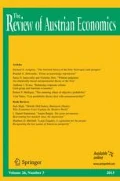Abstract
It is maintained that a closer analysis of the features of the underlying contract reveals that under many circumstances corruption is in fact a rational and understandable reaction to institutional failures, which are often far from accidental. Sometimes it can even be considered legitimate, when instrumental in achieving goals shared by the vast majority of the electorate.
To this purpose, three different stylized institutional frameworks are analyzed: developed, totalitarian and transition countries. The origin, scope and consequences of corruption vary significantly across the different frameworks. The normative conclusions should therefore be adjusted accordingly.
Similar content being viewed by others
References
Ades, Alberto and Di Tella, Rafael (1999) “Rents, Competition, and Corruption.” American Economic Review, 89(4): 982–993.
Banfield, Edward (1975) “Corruption as a Feature of Governmental Organization.” Journal of Law and Economics, 18(3): 587–605.
Chapman, Bruce (1998) “Between Markets and Politics: A Social Choice Theoretic Appreciation of the Charitable Sector.” George Mason Law Review, 6: 821–867.
Colombatto, Enrico and Macey, Jonathan (1999) “Information and Transaction Costs as the Determinants of Politically Tolerable Growth Levels.” Journal of Institutional and Theoretical Economics, 155: 617–642.
De Jouvenel, Bertrand (1945) Du Pouvoir: Histoire Naturelle de sa Croissance. Genève: Les Éditions du Cheval Ailé (republished in English in Indianapolis: The Liberty Fund, 1993).
Della Porta, Antonella and Vannucci, Alberto (1997) “The 'Perverse Effect' of Political Corruption.” Political Studies. XLV, 3 (Special Issue on Political Corruption Edited by Paul Heywood): 516–538.
Dixit, Avinash (1996) The Making of Economic Policy. Cambridge, MA: MIT Press.
Easterly, William (2002) “The Cartel of Good Intentions: Markets vs. Bureaucracy in Foreign Aid.” Working Paper, no. 4, March. Washington: Center for Global Development.
Hancock, Graham (1989) Lords of Poverty. New York: Atlantic Monthly Press.
Jain, Arvind K. (1998) “Corruption: An Introduction.” In: Jain, Arvind K. (Ed.), Economics of Corruption, pp. 1–12. Boston: Kluwer Academic Publishers.
Kaminski, Antoni and Kaminski, Bartlomej (2001) “Governance and Corruption in Transition: The Challenge of Subverting Corruption.” Economic Survey of Europe 2001, no. 2, New York and Geneva: United Nations: 117–144.
Kaufmann, Daniel (1997) “Corruption: The Facts.” Foreign Policy, 107: 114–131.
Kaufmann, Daniel (1998a) “Research on Corruption: Critical Empirical Issues.” In: Jain, Arvind K. (Ed.) Economics of Corruption, pp. 129–176. Boston: Kluwer Academic Publishers.
Kaufmann, Daniel (1998b) “Corruption in Transition Economies.” In: Newman, Paul (Ed.) The New Palgrave Dictionary of Economics and the Law, pp. 522–530. London: MacMillan.
Lederman, Daniel, Loayza, Norman, and Soares, Rodrigo Reis (2001) “Accountability and Corruption. Political Institutions Matter.” Working Paper. Washington: The World Bank.
Martens, Bertin (Ed.), Mummert, Uwe, Murrell, Peter, and Seabright, Paul (2001) The Institutional Economics of Foreign Aid. Cambridge: Cambridge University Press.
Mauro, Paolo (1997) “Why Worry about Corruption?” Economic Issues, Vol. 6. Washington: International Monetary Fund.
Mbaku, John (2000) Bureaucratic and Political Corruption in Africa: The Public Choice Perspective. Malabar, FL: Krieger Publishing Company.
Murphy,Kevin, Shleifer, Andrei, and Vishny, Robert (1993) “Why is Rent-Seeking so Costly to Growth.” American Economic Review, 83(2): 409–414.
Persson, Torsten, Tabellini, Guido, and Trebbi, Francesco (2001) “Electoral Rules and Corruption.”Working Paper. Stockholm: Institute for International Economic Studies.
Raico, Ralph (2004) Classical Liberalism: Historical Essays in Political Economy. London and New York: Routledge, forthcoming.
Rose-Ackerman, Susan (1998) “Corruption.” In: Newman, Peter (Ed.), The NewPalgrave Dictionary of Economics and the Law, pp. 517–522. London: MacMillan.
Sumner, Xiaohang (1996) “Commitment with Selfish Regulators.” Canadian Journal of Economics, 29: S265–S269.
Tanzi, Vito and Davoodi, Hamid (1998) “Roads to Nowhere: How Corruption in Public Investment Hurts Growth.” Economic Issues, Vol. 12. Washington: International Monetary Fund.
Wei, Shan-Jin (2001) “Corruption in Economic Transition and Development: Grease or Sand?” Economic Survey of Europe 2001, No. 2, New York and Geneva: United Nations: 101–112.
World Bank (2000) Helping Countries Combat Corruption: Progress at the World Bank since 1997. Washington, DC: OCS/PREM, World Bank.
Zakaria, Fareed (1997) “The Rise of Illiberal Democracy.” Foreign Affairs, Nov./Dec.: 22–43.
Author information
Authors and Affiliations
Rights and permissions
About this article
Cite this article
Colombatto, E. Why is Corruption Tolerated?. The Review of Austrian Economics 16, 363–379 (2003). https://doi.org/10.1023/A:1027349206371
Issue Date:
DOI: https://doi.org/10.1023/A:1027349206371



